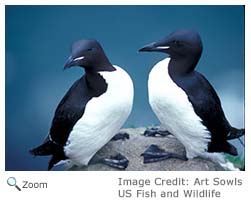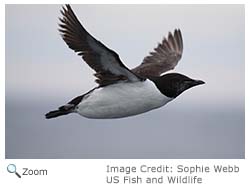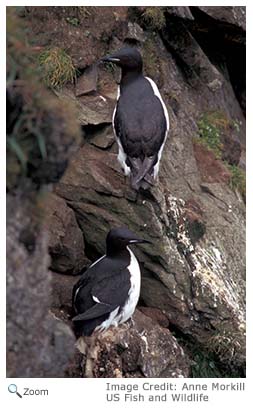Thick-billed Murre - Uria lomvia |
|||||||||||
Description RangeThe thick-billed murre breeds off the coasts of Alaska, Canada, Greenland, Scandinavia, and Russia. It winters in coastal areas south to southern Alaska and New Jersey. When it is not breeding, it lives on the open sea. Habitat
| DietThe thick-billed murre eats fish, squid, and various crustaceans. It dives under the water to pursue its prey. The thick-billed murre is much better at swimming than it is at flying! Life Cycle The female thick-billed murre lays a single large bluish-green egg on a narrow ledge. Thick-billed murres don't build nests, but they may move rocks and pebbles to their nesting site. The rocks and pebbles may become stuck together by the thick-billed murre's droppings and form a barrier that helps keep the egg from rolling off the cliff. Both parents incubate the egg. The egg hatches in 30-35 days. Both parents feed the chick. One parent will stay with the chick while the other parent looks for food. The chick leaves the nest when it is around 20 days old. The male will stay with it for a few weeks after it leaves the nest.
BehaviorThe thick-billed murre can dive to depths of close to 600 feet. It uses its short, stubby wings to "fly" through the water. |
||||||||||
Audio Credit: xeno-canto.org Andrew Spencer |
|||||||||||



